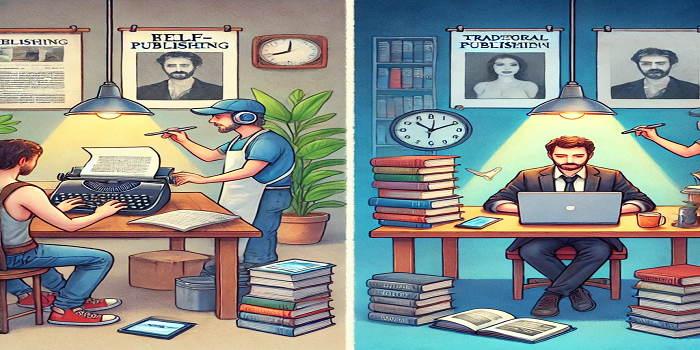Introduction
Aspiring authors often face a big decision: Should I self-publish or go the traditional publishing route?
Each path comes with its own set of advantages and challenges, and the right choice depends on your goals, priorities, and expectations. Do you want complete creative control, or would you rather work with an established publisher? Are you looking for prestige and industry recognition, or do you want to maximize your earnings?
In this guide, we’ll break down the key differences, pros, and cons of both publishing options to help you determine which path is best for you.
Key Differences Between Traditional and Self-Publishing
The most significant differences between traditional publishing and self-publishing revolve around control, cost, royalties, and marketing.
| Feature | Traditional Publishing | Self-Publishing |
| Control | Publisher makes major decisions | Full creative control |
| Cost | No upfront cost (publisher covers expenses) | Author pays for editing, cover design, marketing |
| Royalties | 10-15% per book | 35-70% per book |
| Marketing | Limited publisher support | Author handles all marketing |
| Time to Publish | 1-2 years (querying + production) | A few months |
| Distribution | Wide bookstore and library access | Mostly online (Amazon, Kobo, etc.) |
Now, let’s explore each publishing model in depth so you can make an informed decision.
Traditional Publishing: The Pros and Cons
What is Traditional Publishing?
Traditional publishing means your book is published by a traditional publishing house (such as Penguin Random House, HarperCollins, or Simon & Schuster). You typically need to secure a literary agent, who will submit your manuscript to publishers on your behalf. If accepted, the publisher handles all aspects of book production, marketing, and distribution.
Pros of Traditional Publishing
✅ Credibility and Prestige – Getting published by an established publishing house adds legitimacy to your work.
✅ No Upfront Costs – The publisher covers editing, design, and printing expenses.
✅ Wide Distribution – Your book has a better chance of being stocked in bookstores, libraries, and major retailers.
✅ Editorial & Marketing Support – You get professional editing, cover design, and some level of promotion.
Cons of Traditional Publishing
❌ Difficult to Break Into – Most publishers reject 95% of submissions, making it highly competitive.
❌ Long Time to Publish – Even if accepted, it can take 1-2 years before your book is released.
❌ Low Royalties – Authors typically earn only 10-15% per book sold (compared to self-publishing’s 35-70%).
❌ Limited Creative Control – The publisher chooses the book cover, title, and marketing strategy.
Who Should Consider Traditional Publishing?
- Writers who value industry recognition and credibility.
- Authors who want their book in physical bookstores and libraries.
- Those who don’t want to handle marketing and publishing logistics.
Self-Publishing: The Pros and Cons
What is Self-Publishing?
Self-publishing means you retain full control over your book’s production, pricing, and distribution. Instead of relying on a publisher, you can release your book through platforms like Amazon Kindle Direct Publishing (KDP), IngramSpark, Kobo, and Apple Books.
Pros of Self-Publishing
✅ Full Creative Control – You decide on the book’s content, cover design, pricing, and marketing strategy.
✅ Higher Royalties – Authors earn 35-70% per book sale, compared to 10-15% in traditional publishing.
✅ Faster Publishing Process – You can publish within weeks or months, rather than waiting years.
✅ No Gatekeepers – You don’t need a literary agent or a publisher’s approval you control your career.
Cons of Self-Publishing
❌ Upfront Costs – You must invest in editing, cover design, and marketing yourself.
❌ Marketing is 100% on You – Success depends on how well you promote your book.
❌ Harder to Get into Bookstores & Libraries – Most self-published books are sold primarily online.
❌ Quality Control Issues – Since anyone can self-publish, poorly edited books flood the market, making it harder to stand out.
Who Should Consider Self-Publishing?
- Writers who want full creative and financial control.
- Authors willing to invest in marketing and book production.
- Those who prefer faster publishing timelines and higher royalties.
Which One is Right for You?
Both traditional and self-publishing have strengths and weaknesses. The best choice depends on your goals, patience, and willingness to take on different responsibilities.
Go with Traditional Publishing if:
✔ You seek industry validation and credibility.
✔ You want a professional team to handle editing, design, and distribution.
✔ You’re willing to wait 1-2 years for your book to be published.
✔ You’re comfortable earning lower royalties in exchange for wider reach.
Go with Self-Publishing if:
✔ You want full creative control over your book.
✔ You prefer higher royalties and faster publication timelines.
✔ You’re willing to invest in marketing and production.
✔ You enjoy entrepreneurship and building a brand.
Making the Best Choice for Your Writing Career
There is no one-size-fits-all answer both publishing paths offer unique benefits. It all depends on what you prioritize:
- If you want control, higher earnings, and a fast turnaround, self-publishing is the way to go.
- If you prefer prestige, a professional team, and bookstore distribution, traditional publishing might be a better fit.
Key Takeaways:
✅ Traditional Publishing – Best for those seeking prestige, professional support, and wider bookstore access.
✅ Self-Publishing – Ideal for authors who want creative control, higher profits, and fast publishing.
✅ Hybrid Publishing – Some authors choose a mix self-publishing some books while pursuing traditional deals for others.
Whichever path you choose, remember: Your book’s success ultimately depends on your dedication, marketing strategy, and passion for storytelling. 🚀📚

